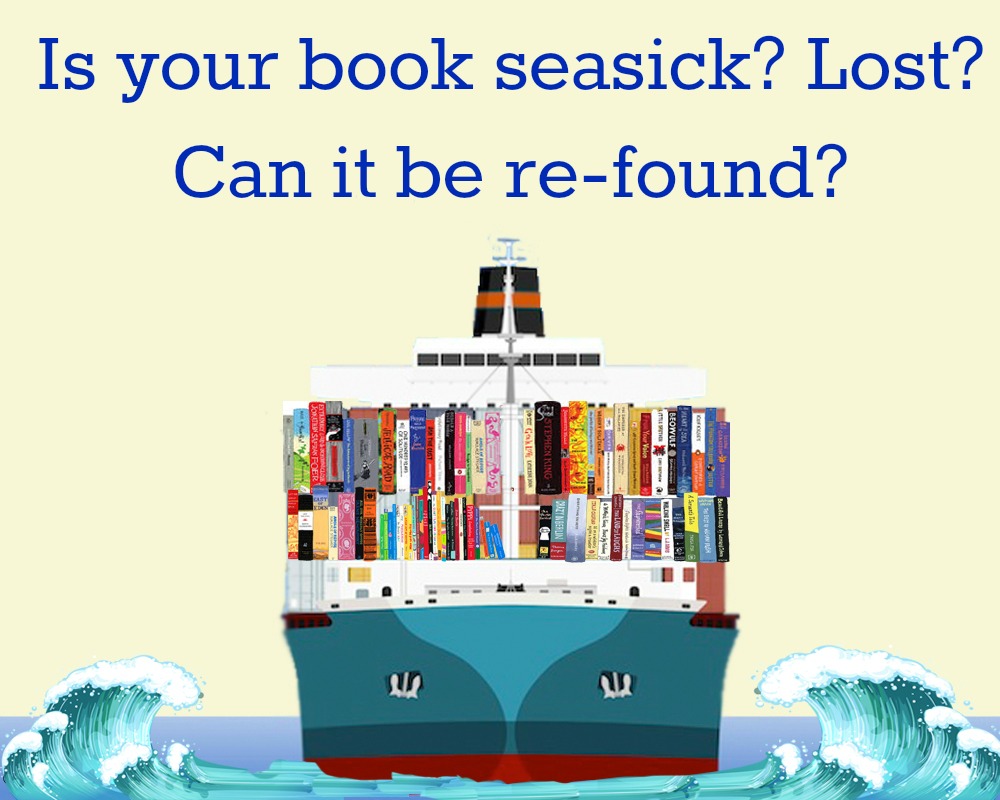Amazon changed the publishing field—a great thing for so many newbie authors who didn’t think New York or an agent would ever give them a moment’s notice … and it’s also a not so good thing. The level of book pollution has gone beyond the stratosphere.
Anyone and almost everyone can vomit out words and dump them into Amazon’s CreateSpace or get in bed with the growing number of vanity-type presses and in days, literally days, have a book in hand. Is it a quality book or a great looking book? Most likely, not. Too many launch with little to no editing. Ditto with interior and cover design.
Which means that finding buyers—the potential Super Fans—has become fierce. And for authors—all authors—getting found has become the eighth wonder of the world.
Has your book become a sardine in the sea of books available?
Is it lost? Can it be found? Can it become a whale so your buying public can’t miss it?
-
Start with a reality check.
Is your book a good product … really? Does it look self-published? Is it riddled with typos and/or errors? I know the DIYers are going to squawk claiming that theirs is “OK enough—I got a graphics guy on Fivrr to do the cover and used the template to drop my Word document into—it’s OK.”
My eyeballs hurt from looking at the “good enoughs” and I’ve stopped as soon as I spot multiple typos, sentences that make no sense and/or the book looks like it came off a gluing session at the kitchen table. Truthiness: you must care enough about the reader that he or she will care about you and your words.
If you have primary text and/or a book that doesn’t entail a lot of art and budget is an issue, discover Joel Friedlander’s array of templates for interior design—you have plenty to choose from for minimal dollars that will gussy up your DIY image pronto. You can get them on BookDesignTemplates.com or, early in 2016, through Ingram Spark for authors who publish there.
-
Is your book in the right genre?
Yes, you are doing the Happy Dance—you have a book and are ready to start selling it. Amazon will most likely be your primary selling point. Amazon gives you a couple of choices … you need to deep dive to make sure yours lands where it should be. Get registered on Amazon’s Advantage account or through its Marketplace. Then create an Author Central account—this opens the portal to talk to a live person within seconds—a feat that all marvel at when it happens with Amazon.
Interestingly, Amazon’s KDP, eBook categories are more expansive than the print book. In either case, you need to see where your competitors are posted and determine what other options you have. The truth is that your romance or mystery will land in an expansive sea and disappear.
One of the easiest actions to take to help book sales is to change the genre and category. Having a book lost in the sea of genres is frustrating for any author. For fiction, romance and mystery are the biggies—you become the mini-sardine in the swim with the hundreds of thousands of titles already in place plus more coming on every day.
Here’s a hot tip: make your own specific category and reduce the competition. What? Yup, you can in the Kindle arena. There are plenty of “tricks” in dealing with Amazon and its robots.
How do you get into these categories if you can’t select them from the Amazon’s dashboard? Good question. First, you must select Non-Classifiable as one of your categories, and then you email KDP through the dashboard with the full path of the category you want to appear in. For example:
Kindle Store > Kindle eBooks > Literature & Fiction > Genre Fiction > Mystery & Thrillers > Mystery > Series.
David Gaughran wrote an excellent article on deep-diving into categories (and even making your own)—it’s worth a read here: http://www.selfpublishingadvice.org/self-publishers-use-amazon-categories-to-drive-more-sales-50-ways-to-reach-your-reader-10/
-
Is your cover terrific?
I don’t care what all the DIYers say, if your cover sucks, buyers don’t want to pick it up. Get a professional designer into play. No matter how good your book is, a lousy cover will kill your sales. Book covers are your beacon—come to me, pick me up—are their job. Does yours do that?
-
Unpublish.
Say what … take my baby off the market? Look, if your book isn’t working—the reviews that you have aren’t so hot; there are no sales; something is wrong. In other words, are you dragging a dead cat around?
Pull it off the market pronto.
If you had print on demand, it’s a piece of cake. If you have cases of them in your garage, storage, or a warehouse—let them sit … and do a reality check. Ask a few people to read your book and candidly, point out all that doesn’t work in their opinion. Tell them to be brutally honest. Put on a thick hide, you may need it.
You may have to do a total rewrite—you may need a coach here; you may have to redesign the whole thing; or your cover may be as appealing as a seven hour lecture on dissecting a toad. Whatever feedback comes back, put your big author pants on and listen. Keeping a crummy looking/reading book out there will only have a negative effect on your future work that you create. If you can fix it—do it. If you can’t, trash it.
-
Blogging is your friend.
Does your blog need a visual makeover? Sometimes a design change can be the golden egg for visitors. Don’t get them complicated and full of clutter to pull the eye away.
Your blog needs the 3 C’s:
- consistency,
- content
- and commitment.
If you decide that Tuesday is your day—then every Tuesday, yours is out; deciding on the “flavor” is up to you—but your readers will be coming to your blog due to YOU and YOUR EXPERTISE that you deliver every Tuesday (yes, your blog should pop on all holidays as well). Few will sign on (or stick around) if you aren’t committed to the long run.
Once you get a one day a week blog up and going, expand it to two—your readers want fresh content.
So … freshen up your blog if needed—it never hurts … think of the seasons—consistent; always a commonality, yet there are variables and sometimes surprises to each. Let your blog reflect the same.
-
Social media is HUGE to your marketing efforts.
Of course, you do shout-outs via your blog, your expertise, and your presence. Twitter lasts about a minute—so tweet often with variations of the tweet. It can be great traffic generator to your blog—focus on using it to attract others to you, your blog and its content. Facebook has been a common ground for authors, with much happening on Pinterest and now Instagram. Creating a Group on LinkedIn or Facebook may be a perfect platform and avenue for you to develop a following.
Don’t forget Google+. Every time you post on Google+, it is indexed by Google Search along with your profile image! Huge tip: create a headline. To do this, put a star at the beginning and end of your headline, than add the rest of your text. Example: *This Is My Headline *. What happens? You get a twofer: the Google gods will pop out the headline in a bold format and index your posting almost instantly. Nice.
Your social media is not about “buy my book” … it’s about connecting, engaging, sharing information that you have identified yourself as an expert in (yes—both fiction and nonfiction authors are “experts”). Once your readers and followers “get you” … you have SuperFans in the making. Book sales will follow.
-
Don’t abandon the author ship.
It’s easy to claim that no one is reading; no one is buying books. And it’s nonsense. The numbers prove you wrong—last year, there was over $700,000,000 in print sales alone. People read in a variety of formats: print, “e” and audio.
The most successful authors weren’t—as in WERE NOT—overnight successes. Passion … Persistence … Perseverance were their guiding lights. Along with a good dose of reality checking.
Judith Briles is a book publishing expert and coach. She empowers authors and  is the Founder of Author U, a membership organization created for the serious author who wants to be seriously successful. She’s been writing about and conducting workshops on publishing since the 80s. Judith is the author of 34 books including Author YOU: Creating and Building Your Author and Book Platforms (ForeWord IndieFab Book of the Year), Snappy Sassy Salty: Wise Words for Authors and Writers and a speaker at publishing conferences. Book #34 was published this summer: The CrowdFunding Guide for Authors & Writers. Get your copy.
is the Founder of Author U, a membership organization created for the serious author who wants to be seriously successful. She’s been writing about and conducting workshops on publishing since the 80s. Judith is the author of 34 books including Author YOU: Creating and Building Your Author and Book Platforms (ForeWord IndieFab Book of the Year), Snappy Sassy Salty: Wise Words for Authors and Writers and a speaker at publishing conferences. Book #34 was published this summer: The CrowdFunding Guide for Authors & Writers. Get your copy.
Become part of her inner circle by joining the Author’s Ark and exclusive monthly webinar and coaching event. Each summer, she holds Judith Briles Book Publishing Unplugged, a three day intensive limited to a small group of authors who want to be seriously successful. In 2015, the dates are August 27-29th. Her audio and workbook series, Creating Your Book and Author Platform is now available. Join Judith live on Thursdays at 6 p.m. EST for Author U – Your Guide to Book Publishing on the Toginet Network at bit.ly/PublishingShow .
Follow @AuthorU and @MyBookShepherd on Twitter and do a “Like” at AuthorU and Judith Briles – TheBookShepherd on Facebook. If you want to create a book that has no regrets, contact Judith at Judith@Briles.com.
 Author U is a non-profit membership organization dedicated to the author who wants to be seriously successful. Monthly education programs delivered face-to-face and online, The Author Resource ezine, BookCamps and the annual Author U Extravaganza are tools designed for authors pre, during and post publishing of their books. Join AuthorU.org today.
Author U is a non-profit membership organization dedicated to the author who wants to be seriously successful. Monthly education programs delivered face-to-face and online, The Author Resource ezine, BookCamps and the annual Author U Extravaganza are tools designed for authors pre, during and post publishing of their books. Join AuthorU.org today.
If you are looking for FREE author and book coaching … call in to Judith’s Author Monday Mornings at NOON Eastern each Monday. The number is 218-632-9854; Access Code 1239874444 … have your questions ready–there’s a full hour to ask and listen.


